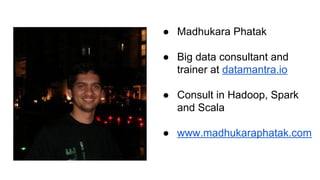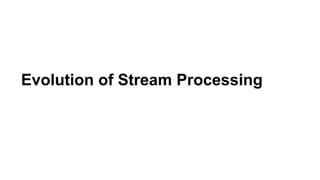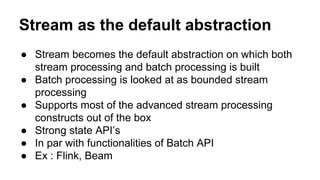Introduction to Structured streaming
- 1. Introduction to Structured Streaming Next Generation Streaming API for Spark https://github.com/phatak-dev/spark2.0-examples/tree/master/src/main/scala/co m/madhukaraphatak/examples/sparktwo/streaming
- 2. ● Madhukara Phatak ● Big data consultant and trainer at datamantra.io ● Consult in Hadoop, Spark and Scala ● www.madhukaraphatak.com
- 3. Agenda ● Evolution in Stream Processing ● Drawbacks of DStream API ● Introduction to Structured Streaming ● Understanding Source and Sinks ● Stateful stream applications ● Handling State recovery ● Joins ● Window API
- 4. Evolution of Stream Processing
- 5. Stream as Fast Batch Processing ● Stream processing viewed as low latency batch processing ● Storm took stateless per message and spark took minibatch approach ● Focused on mostly stateless / limited state workloads ● Reconciled using Lamda architecture ● Less features and less powerful API compared to the batch system ● Ex : Storm, Spark DStream API
- 6. Drawbacks of Stream as Fast Batch ● Handling state for long time and efficiently is a challenge in these systems ● Lambda architecture forces the duplication of efforts in stream and batch ● As the API is limited, doing any kind of complex operation takes lot of effort ● No clear abstractions for handling stream specific interactions like late events, event time, state recovery etc
- 7. Stream as the default abstraction ● Stream becomes the default abstraction on which both stream processing and batch processing is built ● Batch processing is looked at as bounded stream processing ● Supports most of the advanced stream processing constructs out of the box ● Strong state API’s ● In par with functionalities of Batch API ● Ex : Flink, Beam
- 8. Challenges with Stream as default ● Stream as abstraction makes it hard to combine stream with batch data ● Stream abstraction works well for piping based API’s like map, flatMap but challenging for SQL ● Stream abstraction also sometimes make it difficult to map it to structured world as in the platform level it’s viewed as byte stream ● There are efforts like flink SQL but we have to wait how it turns out
- 9. Drawbacks of DStream API
- 10. Tied to Minibatch execution ● DStream API looks stream as fast batch processing in both API and runtime level ● Batch time integral part of the API which makes it minibatch only API ● Batch time dicates how different abstractions of API like window and state will behave
- 11. RDDs based API ● DStream API is based on RDD API which is deprecated for user API’s in Spark 2.0 ● As DStream API uses RDD, it doesn’t get benefit of the all runtime improvements happened in spark sql ● Difficult to combine in batch API’s as they use Dataset abstraction ● Running SQL queries over stream are awkward and not straight forward
- 12. Limited support for Time abstraction ● Only supports the concept of Processing time ● No support for ingestion time and event time ● As batch time is defined at application level, there is no framework level construct to handle late events ● Windowing other than time, is not possible
- 13. Introduction to Structured Streaming
- 14. Stream as the infinite table ● In structured streaming, a stream is modeled as an infinite table aka infinite Dataset ● As we are using structured abstraction, it’s called structured streaming API ● All input sources, stream transformations and output sinks modeled as Dataset ● As Dataset is underlying abstraction, stream transformations are represented using SQL and Dataset DSL
- 15. Advantage of Stream as infinite table ● Structured data analysis is first class not layered over the unstructured runtime ● Easy to combine with batch data as both use same Dataset abstraction ● Can use full power of SQL language to express stateful stream operations ● Benefits from SQL optimisations learnt over decades ● Easy to learn and maintain
- 16. Source and Sinks API
- 17. Reading from Socket ● Socket is built in source for structured streaming ● As with DStream API, we can read socket by specifying hostname and port ● Returns a DataFrame with single column called value ● Using console as the sink to write the output ● Once we have setup source and sink, we use query interface to start the execution ● Ex : SocketReadExample
- 18. Questions from DStream users ● Where is batch time? Or how frequently this is going to run? ● awaitTermination is on query not on session? Does that mean we can have multiple queries running parallely? ● We didn't specify local[2], how does that work? ● As this program using Dataframe, how does the schema inference works?
- 19. Flink vs Spark stream processing ● Spark run as soon as possible may sound like per event processing but it’s not ● In flink, all the operations like map / flatMap will be running as processes and data will be streamed through it ● But in spark asap, tasks are launched for given batch and destroyed once it’s completed ● So spark still does minibatch but with much lower latency.
- 21. Spark Execution Graph a b 1 2 3 4 Batch 1 Map Stage Aggregat e Stage Spawn tasks Batch 2 Map Stage Aggregat e Stage Sink Stage Sink Stage Spawn tasks Socket Stream
- 22. Independence from Execution Model ● Even though current structured streaming runtime is minibatch, API doesn’t dictate the nature of runtime ● Structured Streaming API is built in such a way that query execution model can be change in future ● Already plan for continuous processing mode to bring structured streaming in par with flink per message semantics ● https://issues.apache.org/jira/browse/SPARK-20928
- 23. Socket Minibatch ● In last example, we used asap trigger. ● We can mimic the DStream mini batch behaviour by changing the trigger API ● Trigger is specified for the query, as it determines the frequency for query execution ● In this example, we create a 5 second trigger, which will create a batch for every 5 seconds ● Ex : SocketMiniBatchExample
- 24. Word count on Socket Stream ● Once we know how to read from a source, we can do operations on the same ● In this example, we will do word count using Dataframe and Dataset API’s ● We will be using Dataset API’s for data cleanup/preparation and Dataframe API to define the aggregations ● Ex : SocketWordCount
- 26. Stateful operations ● In last example, we observed that spark remembers the state across batches ● In structured streaming, all aggregations are stateful ● Developer needs to choose output mode complete so that aggregations are always up to date ● Spark internally uses the both disk and memory state store for remembering state ● No more complicated state management in application code
- 27. Understanding output mode ● Output mode defines what’s the dataframe seen by the sink after each batch ● APPEND signifies sink only sees the records from last batch ● UPDATE signifies sink sees all the changed records across the batches ● COMPLETE signifies sink sess complete output for every batch ● Depending on operations, we need to choose output mode
- 28. Stateless aggregations ● Most of the stream applications benefit from default statefulness ● But sometime we need aggregations done on batch data rather on complete data ● Helpful for porting existing DStream code to structured streaming code ● Spark exposes flatMapGroups API to define the stateless aggregations
- 29. Stateless wordcount ● In this example, we will define word count on a batch data ● Batch is defined for 5 seconds. ● Rather than using groupBy and count API’s we will use groupByKey and flatMapGroups API ● flatMapGroups defines operations to be done on each group ● We will be using output mode APPEND ● Ex : StatelessWordCount
- 30. Limitations of flatMapGroups ● flatMapGroups will be slower than groupBy and count as it doesn’t support partial aggregations ● flatMapGroups can be used only with output mode APPEND as output size of the function is unbounded ● flatMapGroups needs grouping done using Dataset API not using Dataframe API
- 31. Checkpoint and state recovery ● Building stateful applications comes with additional responsibility of checkpointing the state for safe recovery ● Checkpointing is achieved by writing state of the application to a HDFS compatible storage ● Checkpointing is specific for queries. So you can mix and match stateless and stateful queries in same application ● Ex : RecoverableAggregation
- 33. File streams ● Structured Streaming has excellent support for the file based streams ● Supports file types like csv, json,parquet out of the box ● Schema inference is not supported ● Picking up new files on arrival is same as DStream file stream API ● Ex : FileStreamExample
- 34. Joins with static data ● As Dataset is common abstraction across batch and stream API’s , we can easily enrich structured stream with static data ● As both have schema built in, spark can use the catalyst optimiser to optimise joins between files and streams ● In our example,we will be enriching sales stream with customer data ● Ex : StreamJoin
- 35. References ● http://blog.madhukaraphatak.com/categories/introductio n-structured-streaming/ ● https://databricks.com/blog/2017/01/19/real-time-stream ing-etl-structured-streaming-apache-spark-2-1.html ● https://flink.apache.org/news/2016/05/24/stream-sql.htm l


















![Questions from DStream users
● Where is batch time? Or how frequently this is going to
run?
● awaitTermination is on query not on session? Does
that mean we can have multiple queries running
parallely?
● We didn't specify local[2], how does that work?
● As this program using Dataframe, how does the schema
inference works?](https://image.slidesharecdn.com/introductiontostructuredstreaming-171014154555/85/Introduction-to-Structured-streaming-18-320.jpg)
















